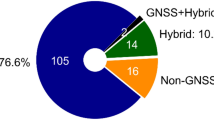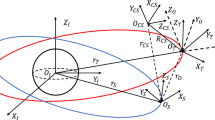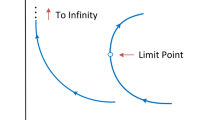Abstract
The multi-objective optimization of transfer trajectories from an orbit near Earth to a periodic libration-point orbit in the Sun–Earth system using the mixed low-thrust and invariant-manifold approach is investigated in this paper. A two-objective optimization model is proposed based on the mixed low-thrust and invariant-manifold approach. The circular restricted three-body model (CRTBP) is utilized to represent the motion of a spacecraft in the gravitational field of the Sun and Earth. The transfer trajectory is broken down into several segments; both low-thrust propulsion and stable manifolds are utilized based on the CRTBP in different segments. The fuel cost, which is generated only by the low-thrust trajectory for transferring the spacecraft from an orbit near Earth to a stable manifold, is minimized. The total flight time, which includes the time during which the spacecraft is controlled by the low-thrust trajectory and the time during which the spacecraft is moving on the stable manifold, is also minimized. Using the nondominated sorting genetic algorithm for the resulting multi-objective optimization problem, highly promising Pareto-optimal solutions for the transfer of the spacecraft are found. Via numerical simulations, it is shown that tradeoffs between time of flight and fuel cost can be quickly evaluated using this approach. Furthermore, for the same time of flight, transfer trajectories based on the mixed-transfer method can save a larger amount of fuel than the low-thrust method alone.






Similar content being viewed by others
References
Gómez, G., Lo, M.W., Masdemont, J.J.: Libration point orbits and applications. World Scientific Publishing, Gerona (2003)
Peng, H.J., Yang, C.F., Li, Y.P., Zhang, S., Chen, B.S.: Surrogate-based parameter optimization and optimal control for optimal trajectory of Halo orbit rendezvous. Aerosp. Sci. Technol. 26(1), 176–184 (2013)
Peng, H.J., Zhao, J., Wu, Z.G., Zhong, W.X.: Optimal periodic controller for formation flying on libration point orbits. Acta. Astronaut. 69(7–8), 537–550 (2011)
Davis, K.E., Anderson, R.L., Scheeres, D.J., Born, G.H.: The use of invariant manifolds for transfers between unstable periodic orbits of different energies. Celest. Mech. Dyn. Astron. 107(4), 471–485 (2010)
Parker, J.S., Davis, K.E., Born, G.H.: Chaining periodic three-body orbits in the Earth–Moon system. Acta. Astronaut. 67(5–6), 623–638 (2010)
Demeyer, J., Gurfil, P.: Transfer to distant retrograde orbits using manifold theory. J. Guid. Control. Dyn. 30(5), 1261–1267 (2007)
Farquhar, R.W., Muhonen, D.P., Newman, C.R., et al.: Trajectories and orbital maneuvers for the first Libration-point satellite. J. Guid. Control. Dyn. 3(6), 549–554 (1980)
Hiday-Johnston, L.A., Howell, K.C.: Transfers between libration-point orbits in the elliptic restricted problem. Celest. Mech. Dyn. Astron. 58(4), 317–337 (1994)
Peng, H.J., Gao, Q., Wu, Z.G., et al.: Optimal guidance based on receding horizon control for low-thrust transfer to libration point orbits. Adv. Space. Res 51(11), 2093–2111 (2013)
Ozimek, M.T., Howell, K.C.: Low-thrust transfers in the Earth–Moon system, including applications to libration point orbits. J. Guid. Control. Dyn. 33(2), 533–549 (2010)
Gómez, G., Marcote, M., Masdemont, J.J.: Trajectory correction manoeuvres in the transfer to libration point orbits. Acta. Astronaut. 56(7), 652–669 (2005)
Xu, M., Xu, S.J.: Trajectory and correction maneuver during the transfer from Earth to Halo orbit. Chin. J. Aeronaut. 21(3), 200–206 (2008)
Li, M.T., Zheng, J.H.: Impulsive lunar Halo transfers using the stable manifolds and lunar flybys. Acta. Astronaut. 66(9–10), 1481–1492 (2010)
Liu, C.B., Hou, X.Y., Liu, L.: Transfer from the Earth to a Lissajous orbit around the collinear libration point by Lunar swing-by. Adv. Space. Res. 40(1), 76–82 (2007)
Serban, R., Koon, W.S., Lo, M.W., et al.: Halo orbit mission correction maneuvers using optimal control. Automatica. 38(4), 571–583 (2002)
Howell, K.C., Barden, B., Lo, M.: Application of dynamical systems theory to trajectory design for a libration point mission. J. Astronaut. Sci. 45(2), 161–178 (1997)
Moore, A., Ober-Blöbaum, S., Marsden, J.E.: Trajectory design combining invariant manifolds with discrete mechanics and optimal control. J. Guid. Control. Dyn. 35(5), 1507–1525 (2012)
Mingotti, G., Topputo, F., Bernelli-Zazzera, F.: Combined optimal low thrust and stable manifold trajectories to the Earth–Moon Halo orbits. AIP Conf. Proc. 886, 100–110 (2007)
Parker, J.S., Anderson, R.L.: Targeting low-energy transfers to low lunar orbit. Acta. Astronaut. 84, 1–14 (2013)
Xu, M., Tan, T., Xu, S.J.: Research on the transfers to Halo orbits from the view of invariant manifolds. Sci. China-Phys. Mech. Astron. 55(4), 671–683 (2012)
Assadian, N., Pourtakdoust, S.H.: Multiobjective genetic optimization of Earth–Moon trajectories in the restricted four-body problem. Adv. Space. Res. 45(3), 398–409 (2010)
Zhang, L., Gao, H., Chen, Z., Sun, Q., Zhang, X.: Multi-objective global optimal parafoil homing trajectory optimization via Gauss pseudospectral method. Nonlinear Dyn. 72(1–2), 1–8 (2013)
Chen, C.T., Pham, H.V.: Trajectory planning in parallel kinematic manipulators using a constrained multi-objective evolutionary algorithm. Nonlinear Dyn. 67(2), 1669–1681 (2012)
Dellnitz, M., Ober-Blöbaum, S., Post, M., Schütze, O., Thiere, B.: A multi-objective approach to the design of low thrust space trajectories using optimal control. Celest. Mech. Dyn. Astr. 105(1–3), 33–59 (2009)
Coffee, T. M., Anderson, R. L., Lo, M. W.: Multiobjective optimization of low-energy trajectories using optimal control on dynamical channels (part I). AIAA/AAS Conf. Proc. AAS 11–129 (2011)
Gómez, G., Koon, W.S., Marsden, J.E., Masdemont, J., Ross, S.D.: Connecting orbits and invariant manifolds in the spatial restricted three-body problem. Nonlinearity 17(5), 1571–1606 (2004)
Betts, J.T.: Survey of numerical methods for trajectory optimization. J. Guid. Control. Dyn. 21(2), 193–207 (1998)
Conway, B.A.: A survey of methods available for the numerical optimization of continuous dynamic systems. J. Optimiz. Theory. App. 152(2), 271–306 (2012)
Hull, D.G.: Conversion of optimal control problems into parameter optimization problems. J. Guid. Control. Dyn. 20(1), 57–60 (1997)
Biegler, L.T.: Nonlinear programming: concepts, algorithms, and applications to chemical processes. SIAM Society for Industrial and Applied Mathematics, Philadelphia (2010)
Peng, H.J., Gao, Q., Wu, Z.G., et al.: Symplectic adaptive algorithm for solving nonlinear two-point boundary value problems in astrodynamics. Celest. Mech. Dyn. Astron. 110(4), 319–342 (2011)
Arnold, V.I.: Mathematical methods of classical mechanics. Springer, New York (1989)
Kulkarni, J.E., Campbell, M.E., Dullerud, G.E.: Stabilization of spacecraft flight in Halo orbits: an H\(\infty \) approach. IEEE. Technol. Contr. Syst. Trans. 14(3), 572–578 (2006)
Deb, K.: Multiobjective optimization using evolutionary algorithms. Wiley, New York (2001)
Acknowledgments
The authors are grateful to the financial supports of the National Science Foundation of China (11102031), the Fundamental Research Funds for the Central Universities (DUT13LK25), Program Funded by Liaoning Province Education Administration (L2013015) and the State Key Laboratory of Mechanics and Control of Mechanical Structures (MCMS-0114G02).
Author information
Authors and Affiliations
Corresponding author
Rights and permissions
About this article
Cite this article
Peng, H., Chen, B. & Wu, Z. Multi-objective transfer to libration-point orbits via the mixed low-thrust and invariant-manifold approach. Nonlinear Dyn 77, 321–338 (2014). https://doi.org/10.1007/s11071-014-1296-2
Received:
Accepted:
Published:
Issue Date:
DOI: https://doi.org/10.1007/s11071-014-1296-2




